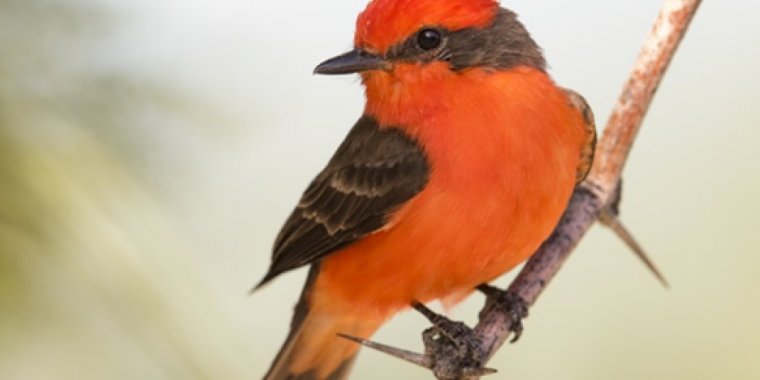| News / Science News |
Bright colors in the animal kingdom: Why some use them to impress and others to intimidate
High up in a tree sits a bright red vermilion flycatcher. The males of this songbird species use their red feathers to attract females. Meanwhile, an Arizona mountain kingsnake slithers among the rocks below. Its vivid red, yellow and black coloring mimics that of the venomous coral snake to keep predators away. But why did these two species evolve similar colors to send completely different messages?

Vermilion flycatchers are found throughout the southwestern U.S. and well into South America. Photo: Mick Thompson/Flickr
Researchers at the University of Arizona set out to better understand how vibrant color patterns evolved in land vertebrates.
They found a strong and consistent link between the function of animals' bright colors and the activity patterns of their ancestors.
Species that use their bright colors as a sexual signal were found to be descended from ancestors that were active during the day.
Conversely, species that use aposematism — bright coloring that warns predators that species are toxic — were found to have had ancestors that were active at night.
The research was done by Zachary Emberts and John Wiens, both at the UArizona Department of Ecology and Evolutionary Biology. Their findings open a doorway to understanding the evolutionary differences between many of today's colorful species.
"This pattern generally seems to hold across land vertebrates, a group with about 40,000 species that evolved over 350 million years," said Wiens, senior author of the paper.
"It doesn't matter how a species produces the colors. The way that a bird makes red is different from how a lizard makes red, but this general pattern of day-night activity still works."
According to the researchers, vividly colored lizards and birds typically use their coloring as a sexual signal for mates. In contrast, colorful amphibians and snakes generally wear them as a warning signal for predators.
Many of these amphibians and snakes are diurnal, meaning they are active during the day, yet their ancestors were nocturnal, or active during the night.
The results showed no clear connection between warning colors and present-day diurnal or nocturnal activity.
However, when the scientists used evolutionary relationships and statistics to estimate the day-night activity patterns in the ancestors of these species, a pattern emerged: sexual coloration was associated with ancestors that were active during daylight, whereas warning coloration was associated with ancestors that had a nocturnal lifestyle. (U.S. National Science Foundation)
YOU MAY ALSO LIKE





